The fifth-generation Ford Mustang, codenamed S197, is a remarkably easy car to modify for peak drag racing performance, especially a 2011 or later GT variant with its Gen 1 Coyote engine.
Before using this power unit, the Mustang GT had a 4.6-liter V8 with just 315 hp (319 PS) and 325 lb-ft (441 Nm) of torque, as opposed to 412 hp (418 PS) and 390 lb-ft (529 Nm) of torque offered by the Coyote V8.
This engine offers a lot of flexibility to somebody looking to make performance-enhancing modifications to their Mustang. For starters, it’s incredibly easy to modify, especially when it comes to bolt-on upgrades. Second, it’s already reasonably powerful even when stock so it doesn’t take that much for you to nearly double its power output.
Want a supercharger? No problem. You’ll be kicking butt on the road and at stoplights in no time. On the drag strip, though, a twin-turbo setup will work best, especially if you’re serious about breaking records or just keeping the competition in check. Case in point, this heavily modified 2012 Mustang S197, also known as “Great White.”
A lot of work went into this car, but if we were to focus on just one mod, we’d obviously choose the twin 6870 Precision turbo kit. It’s hard to say how much power the car is putting down, but we wouldn’t be surprised if it were in the vicinity of 2,000 hp at the crank. It would certainly explain its ability to cover a quarter-mile in the mid-to-low 7-seconds range consistently.
As you’re about to see, Great White lost just one of multiple races here, and it only lost because it failed to be as quick on that last run as it already proved that it could be in previous races. Its best time was an astonishing 7.44 seconds at 181 mph (292 kph).
This engine offers a lot of flexibility to somebody looking to make performance-enhancing modifications to their Mustang. For starters, it’s incredibly easy to modify, especially when it comes to bolt-on upgrades. Second, it’s already reasonably powerful even when stock so it doesn’t take that much for you to nearly double its power output.
Want a supercharger? No problem. You’ll be kicking butt on the road and at stoplights in no time. On the drag strip, though, a twin-turbo setup will work best, especially if you’re serious about breaking records or just keeping the competition in check. Case in point, this heavily modified 2012 Mustang S197, also known as “Great White.”
A lot of work went into this car, but if we were to focus on just one mod, we’d obviously choose the twin 6870 Precision turbo kit. It’s hard to say how much power the car is putting down, but we wouldn’t be surprised if it were in the vicinity of 2,000 hp at the crank. It would certainly explain its ability to cover a quarter-mile in the mid-to-low 7-seconds range consistently.
As you’re about to see, Great White lost just one of multiple races here, and it only lost because it failed to be as quick on that last run as it already proved that it could be in previous races. Its best time was an astonishing 7.44 seconds at 181 mph (292 kph).







